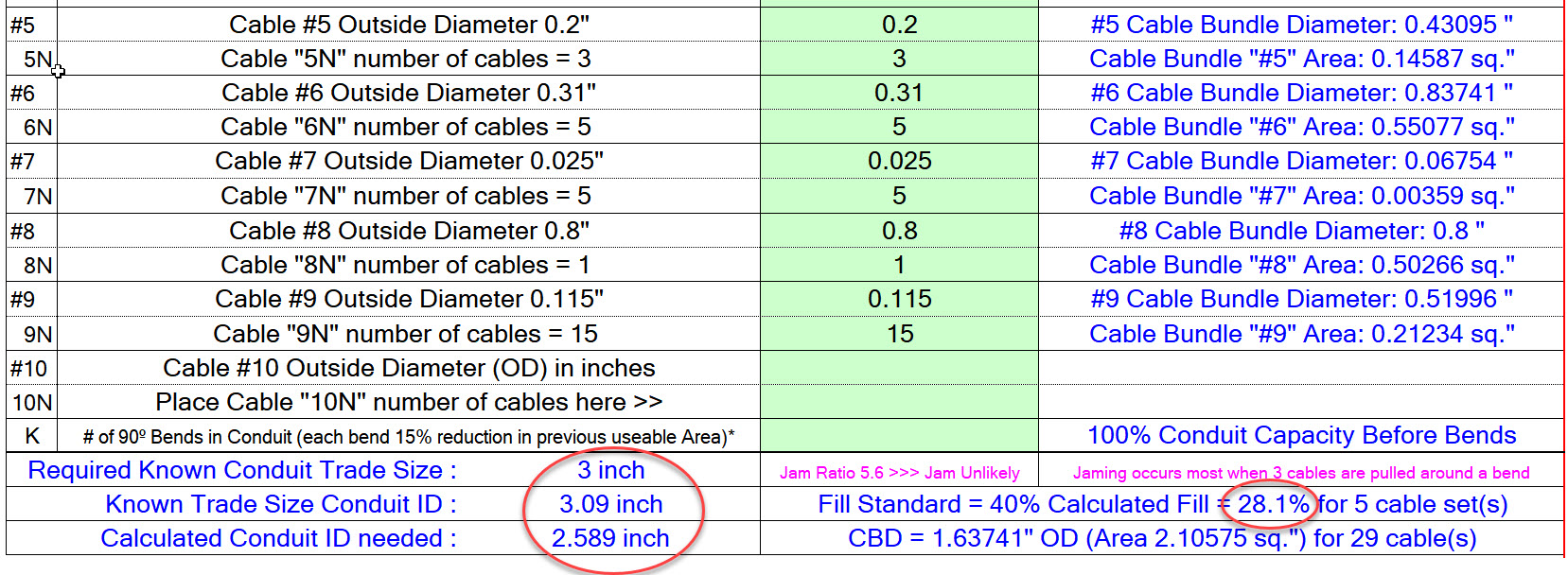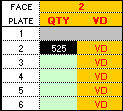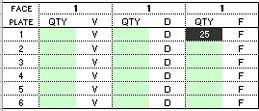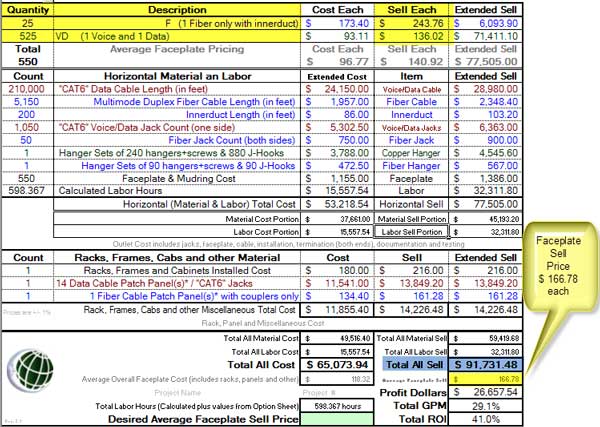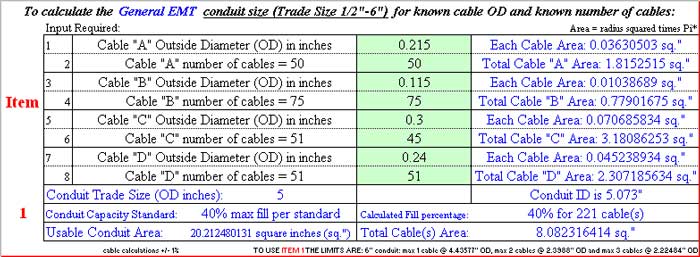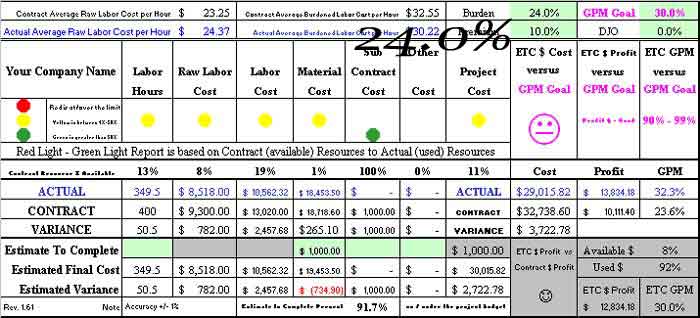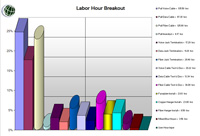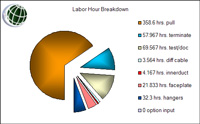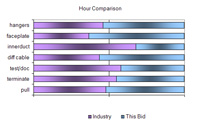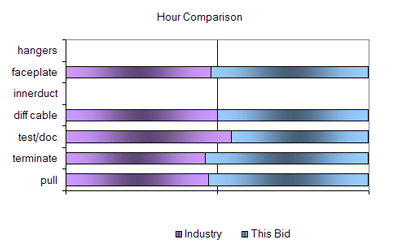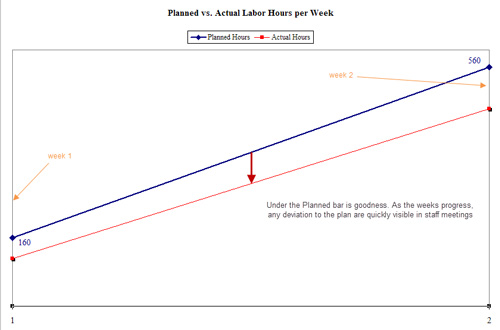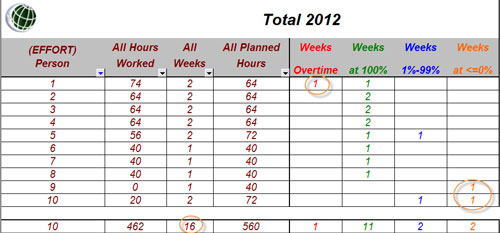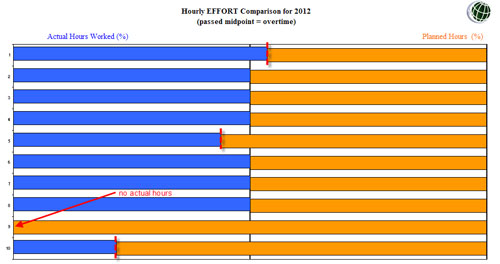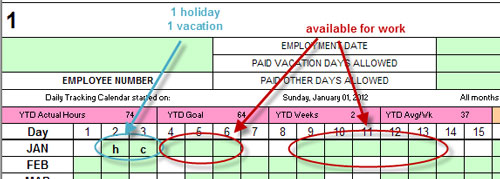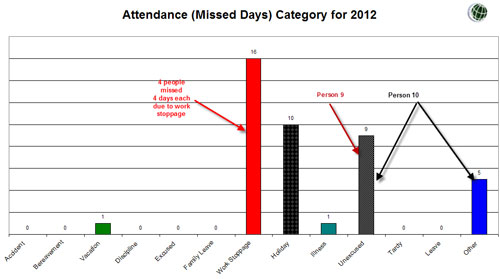 |
Frequently Asked Questions. |  |
Have a question we have not answered? Send us an email - SALES@bidqwik.com
| Your product works with Microsoft's Excel. I have Excel as part of my Office suite of products but do not have the time or the desire to learn how to really use this program. Should I skip your product and look for something similar that is easier to use? | |
| I have a service and associated product material; what should I sell it for? | |
| What profit does my competitor have on the same service & product we provide? | |
| I get $944.08 profit on each product I sell, is this a moneymaker? | |
| Does the product cost change if my company asks me to sell the product at a specific price or gross margin? | |
| My company wants to make good profit but does not insist on a specific GMP or sell price. They rely on me to set the sell price. However, my costs are not fixed. In addition to the usual material & labor costs, I sometimes need to pay parking and subcontractor costs, other times I pay only freight charges. How does this affect the GMP? | |
| Assume I bid a project at a specific sell price, and downstream I find additional costs that I did not count on. How will this affect GMP? | |
| So if I use lower raw-labor rate people to complete the job, the increased costs mentioned above may be offset by the cost decreases from labor? | |
| How does your cost chart work in TrakPro? | |
| Along that same line as question #8 above, how does TrakPro handle the estimate-to-complete (ETC) cost projection? | |
| In TrakPro, what is the "Over/Under Minimum Billing Amount" and what is it used for? | |
| In TrakPro, what is the function of the WIP Sheet? | |
| I have many technicians (at different pay grades), many products, different configurations, variable timeframes and more. How do I calculate the sell, GMP, billing and cash position numbers easily and quickly? | |
| A 3" diameter EMT (3.09" ID) conduit we want to use already has 4 sets of cables (3 cables @ 0.2" OD, 5 cables @ 0.31" OD, 5@0.25", 1@0.8" and 15@0.115").. We want to add 100 cables @ 0.028" dia. Can we still use the 3" Conduit and will we still be to standard at the 40% max fill? | |
| Please
help with the bid price for the following: 525 new CAT6 V/D runs
and 25 new fiber locations. All are at an average 200' distance
from the MDF except 3 fiber runs that are 250 feet station distance.
All voice/data/fiber cables land on patch panels. The
CAT6 cable costs me $0.23 per foot, the multimode fiber cable
is $0.38 per
foot, the rack is $180. The 96 port data panels cost $878.40
each, 12 port data panels $121.80 and the 48 port fiber patch
panel is $134.40 each (with couplers only,unterminated). I mark
up my material 20% and my burdened labor is $26.00 per hour and
the labor sell price is around $54.00 per hour.The customer wants
20% growth on the panels. Can you help?
|
|
| I notice many questions relate to computer cabling projects, does your software handle different business projects? | |
| Do I need to update your programs regularly to keep them current? Do I need to buy additional copies or licenses to run your program on my work and home computers? | |
| Your logo is a moon overlooking the earth. Is there any significance to that? | |
| Peter we have a 6" EMT conduit (6.093" ID) that has 2 -90 degree conduit bends and the following existing 145 cables (5-0.215" OD, 75-0.115" OD, 45-0.22" OD and 20-0.2" OD). We want to add 30-0.24" cables to this conduit (total 175 cables), will we still be to the 40% maximum conduit fill standard? | |
| We are using TrakPro, see below, and was wondering how we can make the 28.3% gross profit margin project look like we made a 30% GPM? We can finish the project (20 hours) with an $18/hour guy but that didn't give us the results we wanted. Please hurry with information! | |
| We are planning a future multi-story building and want to be ahead of the installation game. How much conduit capacity is needed for the CAT6a communications cable? | |
| Our company utilizes the formula for material sell price as Sell = Cost divided by 1 minus the gross margin %. BidPro uses a markup % times the cost. Our formula example for a 40% GPM: the $100 cost = $166.67 sell. BidPro shows a 40% markup so the sell price is $140.00. How can we reflect our Accounting requirements in BidPro? | |
| There is an existing empty 5" EMT conduit that has 3 - 90 degree elbows. The customer asked us to use this existing 75' conduit (due to budget constraints) and install 100 - 0.24" OD cables? | |
| Whom do you recommended as a supplier for communications cabling products? | |
| Question 24: | I have a business that arranges flowers for weddings. I can't seem to make money on this venture because soooo... many people compete in that field. I love what I do but cannot continue to break even or loose money. What can your software do for me? |
| Question 25: | We are using your ConduitPro to determine conduit capacity. Your special fill sheet can calculate up to 4 different cable types, we have a need for 6 to 8 different groups. Can you help? |
| Question 26: | Can we use BidPro in a Hollywood film making project? |
| Question 27: | We use CablePro and want you to add a graphical depicting of our bid material & labor figures. How do we go about asking for an upgrade? |
| Question 28: | Walk me thru LaborPro. As an example: I have 10 people I want to track per project. We have 40 hour work weeks (when business is good) but we have do not have paid holidays or vacation days. |
Question 0: Your product works with Microsoft's Excel. I have Excel as part of my Office suite of products but do not have the time or the desire to learn how to really use this program. Should I skip your product and look for something similar that is easier to use?
Peter Buitenhek Answer: You will not find any product that does all the things our's can do. Our products use Excel because it has worldwide acceptance. The beauty of Excel is that we made it look like a typical input sheet that will give you the results you want without having to program or understand formula structure.
As an example: using our program called, CablePro (determines product quantity, cost and sell price of a horizontal communications cabling project) and the Baseline parmeters: you only need to enter one (1) item to get the following results.
 This
is the entry area where you want to enter the quantity of Fiber - Voice
- Data jacks
This
is the entry area where you want to enter the quantity of Fiber - Voice
- Data jacks You
enter 125 FVD (Fiber-Voice-Data) faceplates. Based on normalized data,
you get:
You
enter 125 FVD (Fiber-Voice-Data) faceplates. Based on normalized data,
you get: 
On this project you would bid $54,455 and make about $22,395 profit. Most contractors just seat-of-the-pants bid $450 per 1Voice/1Data/1Fiber faceplate ($450x125=$56,250), you should have a bid margin advantage because the average sell price is nearer to $436. Also construction loan applications tend to go easier when the bank or financier sees all costs, sell price and Gross Profit Margin. So you see there is no need to understand Excel, but you must understand your product: how it is bid and what your financial needs are. By the way, this bid took less than "20 seconds". return
Peter Buitenhek Answer: It depends on your customer’s perceived value of the product/service and your company’s profit expectations. If your financial people do not dictate a specific profit margin, pick 32%. This magic number has made many companies very rich. Remember the formula for GMP % = Sell minus cost divided by sell times 100%. return
Peter Buitenhek Answer: Ask them! Or use BidPro to determine what your gross profit margin would be if you sold your product & service at their asking price. Using BidPro will allow you to do a Best-and-Final (BAF) where the customer is "looking" for a specific sell price. It quickly "reverse engineers" the numbers to determine what your profit would be if you use the new sell price. return
Peter Buitenhek Answer: Profit is always good. However, what is your product cost? response - $1,256.18.
Peter Buitenhek Answer: If the product costs you $1,256.18, then the sell price would be $2,200.26 at a gross margin of profit (GMP) of 42.9%. Any company would love a GMP over 40%; most companies have numbers ranging from 10% - 30%. However, if for example, your cost of the product was $12,561.80, the sell price would be $13,505.88 at a GMP of 7.0% - that would not be a moneymaker. return
Peter Buitenhek Answer: Not if your costs are fixed. Examples of costs are: material cost, labor burden rate, direct job overhead cost, bonds, parking, permits, per diems and more. return
Peter Buitenhek Answer: Use BidPro and set up each project with a specific GMP or sell price in mind (say 32%). This way you are assured a specific forecast profit. Each project should always have a good profit story to talk about at raise time. Remember Babe Ruth pointing to the right field where he was going to hit that home run! Upper management is impressed if you point to the profit dollars and deliver that amount. By the way, I don't mean fleece the customer, I am an advocate of a good job performed at a fair price! return
Peter Buitenhek Answer: The GMP would decrease by a calculated amount. If this difference is negligible or within tolerance, you may not need to worry. I always allow some product pricing or labor slop for that reason. If the variance is not within tolerance, management needs to be apprised immediately! However, if the bid is very competitive, extra pricing slop may put you over the winning bid so use caution. return
Peter Buitenhek Answer: Project Cost Management. If for example you bid $18.57 per hour labor people and ended up using $15.78 per hour wizards, you could possibly offset the cost difference. Or, you might be able to buy that special tester, at $4,857.58, and still bring the project in at 30% GMP. TrakPro can handle all those conversions easily. People will be impressed. return
Peter Buitenhek Answer: The Contract cost is shown across the (x-axis) baseline and extends left-to-right. After the project starts and actual costs start to accrue, a secondary line (blue) is added to the chart to depict cost relationship. If the actual line costs are to the right (below) of the contract line, the labor, material, subcontractor, and other project total costs are all within contract goals:

If any category costs are to the left (above) the contract goal, the actual line will fall to the left of the contract line signifying you are above contract cost. This easy-to-see graphic format is great for assessing many projects quickly.
Question 9: Along that same line as question #8 above, how does TrakPro handle the estimate-to-complete (ETC) cost projection?
Peter Buitenhek Answer: A tertiary line is added when Estimate-to-Complete (ETC) costs are forecast for project completion. If the ETC line falls below the contract line, the final costs will be below contract goals (yea). Conversely, a line above the contract will signify costs above the goal and suggests cost-saving or limiting measures should be implemented by management.

The process of viewing the line chart is a favorite for most companies. The question at all staff meetings reviewing projects invariable states, “Are we below the line? If so, next project.” return
Peter Buitenhek Answer: Like my previous boss, George Harris, always said, "Hello!"
You need to stay profitable on every phase of the project. Look at the ratio between year-to-date actual plus ETC (estimate-to-complete) costs and compare this to the contract cost amount to determine how far along you are on the project. If you have used 50% of the costs then, hypothetically, you are 50 % done. Therefore, you should be able to bill a minimum of 50% of the total contract "sell" amount. TrakPro compares what you have billed and what you should bill to give you an "over/under" billing dollar amount.
Assume your costs are $365.75 and you have billed the customer $500 contract cost. You are $134.25 over billed. If the customer has paid the $500 invoice, then your cash position is $134.25 over cost. These "over cost" dollars thrill bankers and can be used to fund other projects without mixing project accounting funds. return
Peter Buitenhek Answer: The WIP (work-in-process) Sheet depicts your project standing in cost, profit, minimum billing and cash position. It breaks down overall material, labor and other costs and presents a hypothetical Time & Material (T & M) rate for reference.
TrakPro WIP then provides 3 Options for similar projects:
Option 2. What if we were to fix the material markup costs and/or Labor Rate (T & M)?
Option 3. What if we were to fix the material sell amount?
OPtion 4. What if we were to fix the labor sell amount?
Example: the customer has numerous similar installations and the previous contractor typically charged $500 total for labor. The customer became disenchanted with the current contractor, for whatever reason, and has asked you to bid the project with the proviso that the labor dollar amount be similar. You estimate the project, lock in the Labor Sell Amount, and decide at what GPM you want to bid the project.
A WIP chart will depict cost, sell price and profit dollars.
Peter Buitenhek Answer: The best solution: BidPro & TrakPro from http://www.bidqwik.com return
Peter Buitenhek Answer: So currently, your calculated conduit fill for the 3.09" ID conduit is 28.1%.
The fill percentage for the additional 100 cables (0.028" OD) will be 39.8% which is within the 40% fill standard for 3+ cables.

BTW, a total of 103 cables will still be to standard
at 40% calculated fill.
Question
14: Please
help with the bid price for the following: 525 new CAT6 V/D runs
and 25 new fiber locations. All are at an average 200' distance
from the MDF except 3 fiber runs that are 250 feet station distance.
All voice/data/fiber cables land on patch panels.
The CAT6 cable costs me $0.23 per foot, the multimode fiber
cable
is $0.38 per
foot, the rack is $180. The 96 port data panels cost $878.40
each, 12 port data panels $121.80 and the 48 port fiber patch
panel is $134.40 each (with couplers only,unterminated). I mark
up my material 20% and my burdened labor is $26.00 per hour and
the labor sell price is around $54.00 per hour.The customer wants
20% growth on the panels. Can you help? Each
faceplate combination is broken down by cost and sell pricing.
Most contractors feel
the sell price for a voice/data drop ($136.02)
and a single fiber drop ($243.76) are too low, opting for the
seat-of-the pants $200 per V/D drop
and $300 for
a fiber. But after using the CablePro, many
contractors can actually
see their "real" average costs are a lot lower
($96.77 average cost). For this reason,
all applicable costs are
added to CablePro:
cable, jack, hanger, faceplate, rack, block and panel pricing.
Installation
labor, documentation and testing are also added at the user
specific rate. The Sell Price for you is $91,732.
Question
15: I notice many questions relate to computer cabling projects,
does your software handle different business projects?
Peter Buitenhek Answer: Yes, originally all programs were developed for the cabling industry. There are five (5) software projects that we market; three (3) have been redesigned for any business (BidPro, TrakPro and AttendancePro), the remaining two (2) have stayed strictly for the horizontal cabling industry (CablePro and ConduitPro). We also do custom projects on occasion. We have developed a proprietary FuneralPro were the funeral director can enter all pertinent information after the interview with the family. The program ascertains if all items have been covered, calculates costs and prints the death certificate. This prevents embarrassing come-backs. return Question
16: Do I need to update your programs regularly to keep them
current? Do I need to buy additional copies or licenses to
run your program on my work and home computers? All information that you enter into the programs are your current product-project related items. Each program calculates the complex results using your figures. All formulas and graphs are available through the standard Microsoft-Excel program. To stay ahead of the competition, we do our work at home as well as at work. Use as many copies as required to make your business profitable. If you need copies for additional salespeople, do so. One famous software program developer (unnamed) uses our software structure from two programs as an underlying calculation engine for their software. Everyone that purchases our programs makes money consistently. We have priced these programs ($40 - $80) so you can make your money back ..........in just one project ! return Question 17: Your logo is a moon overlooking the earth. Is there any significance to that? Peter Buitenhek Answer: Yes, I am an amateur astronomer so the original logo was a lunar eclipse.  The
Earth depicts the P in Profit
and the eclipsed moon is the D in Developer. The dot com
(.com) was not easy to see. The
Earth depicts the P in Profit
and the eclipsed moon is the D in Developer. The dot com
(.com) was not easy to see.The lunar eclipse can only occur at Full Moon and only if the Moon passes through some portion of the Earth's shadow. When an eclipse of the Moon takes place, everyone on the night side of Earth can see it. About 35% of all eclipses are of the penumbral type which are very difficult to detect, even with a telescope. Another 30% are partial eclipses which are easy to see with the unaided eye. And the remaining 35% are total eclipses. Similar to these cycles, my software originally was geared to provide a profit in the 30-35% range when all contributing factors were met. As the programs matured so did the logo. The current logo  has
taken on the color of money (green) which is the driving
factor for my programs. In addition, it is also the color
of the Universe when viewed
through
the largest spectroscopic survey
completed to date. Astronomers Karl Glazebrook and Ivan
Baldry of Johns Hopkins University, conducted the Two Degree
Field (2dF) Galaxy Redshift Survey and calculated the current
"cosmic spectrum" is a greenish hue. This galactic glow
was considered bluer six billion years ago when the stars
were
younger. The current pale green will become redder as the
stellar population ages. return has
taken on the color of money (green) which is the driving
factor for my programs. In addition, it is also the color
of the Universe when viewed
through
the largest spectroscopic survey
completed to date. Astronomers Karl Glazebrook and Ivan
Baldry of Johns Hopkins University, conducted the Two Degree
Field (2dF) Galaxy Redshift Survey and calculated the current
"cosmic spectrum" is a greenish hue. This galactic glow
was considered bluer six billion years ago when the stars
were
younger. The current pale green will become redder as the
stellar population ages. return
Question
18: Peter we have
a 6" EMT
conduit (6.093" ID)
that has 2 -90 degree conduit bends and the following
existing 145 cables (5-0.215" OD,
75-0.115" OD,
45-0.22"
OD and 20-0.2" OD). We want to add 30-0.24" cables
to this conduit (total 175 cables), will we still
be to the 40% maximum conduit fill standard? Yes The original 4 cable sets (145 cables) in the 6" EMT Trade Size conduit (6.093" ID) is to standard (actually a 5" Trade size conduit would have sufficed.
So
the 30-0.24" OD
new cables will still fit your existing 6" Trade Size
Conduit. ConduitPro calculated the 170 cables in the 6" Trade
conduit now will have a calculated fill of 28.7%. Question
19: We are using TrakPro, see below, and was wondering how we
can make the 28.3% gross
profit margin project look like we made a 30% GPM? We can
finish the project (20 hours) with an $18/hour guy but that
didn't give us the results we wanted. Please hurry with information! First: Your average actual raw labor rate is $24.76 per hour but you bid less expensive people ($23.25/hr)! However, you made up ground on the labor hours by saving 50.5 hours. Your decision to use an $18.00 per hour person (lowering the actual raw cost to $24.37) is sound advise as long as this person can meet the 20 hours to complete requirements. Second: Your actual GPM is 32.2% and it dropped to 28.3% after your estimate to complete $1,643.60. Your are $734.90 over your material cost estimate and have $1000 available for the subcontractor so you missed the actual material mark by over $1700! Can you trim the $1000 material estimate-to-complete cost? response - No. Finally:
If you use the lower priced person and lower your 30% burden
rate to 24% it will work. Your final profit dollars will
be $12,834.18 which is higher than the $10,111.40 you bid.
Keep in mind that if your "real burden rate" is
actually lower than your 30% bid, you would probably win
more projects (lower
bid price). Question 20: We are planning a conduit rough-in for a future multi-story building and want to be ahead of the installation game. How much conduit capacity is needed for the CAT6a communications cable? Peter Buitenhek Answer: You are referring to Augmented CAT6 UTP (CAT6a) cable which, in 2006, is being considered in draft status by the IEEE 803.2an Standards Committee looking into 10GBase-T Ethernet at 100 meter versus only 37 meters for CAT6. The main issues still deal with properties of shielded twisted-pair (STP) CAT7 cable versus familiar unshielded twisted-pair (UTP) CAT6a cable. Regardless of the choice, I do not believe they will change the max 40% fill ratio for 3+ cables. As such, a 1-1/2" EMT conduit will support 8-CAT6a (nominal outside diameter 0.35") cables versus 20-CAT6 (0.22" OD) cables. A 2" EMT will support 13-CAT6a or 34-CAT6. And for fun, 16-CAT6a and 20-CAT6 will fit into a 2-1/2" EMT at 39.3% fill. return Question 21: Our company utilizes the formula for material sell price as Sell = Cost divided by 1 minus the gross margin %. BidPro uses a markup % times the cost. Our formula example for a 40% GPM: the $100 cost = $166.67 sell. BidPro shows a 40% markup so the sell price is $140.00. How can we reflect our Accounting requirements in BidPro? Peter Buitenhek Answer: Option 2 of the Margins Sheet allows fine tuning of the 20 cost categories. Simply enter your desired gross margin.
Question 22: There is an existing empty 5" EMT (5.073" ID) conduit that has 3 - 90 degree bend elbows. The customer asked us to use this conduit to install 100 - 0.24" OD cables. Will our install be standards compliant? Peter
Buitenhek Answer: The number of bends in a conduit does
not directly affect the conduit’s fill capacity,
but it does impact the ease of pulling cables through the
conduit. The NEC guidelines suggest reducing the conduit
fill area by 15% for each bend (any degree) more
than 2 – 90-degree bends. The
NEC 360-degree bend rule for conduit bending states that there
should be no more than the equivalent of four quarter bends
(360 degrees total) between pull boxes. The rule helps prevent
damage to the cable insulation around the conductors. Each
subsequent cable pull box resets the 360-degree rule. The
Communications Cable capacity is slightly more
rigid, limiting
the number of bends (any degree) to only 2 bends
maximum or 100’ conduit (whichever occurs first) before
another pull box is required. Once the pull box is installed,
all values
start anew.
So make sure there is a pull box after the 2nd bend and limit
max conduit length to 100 feet between pull boxes. The
5" EMT Trade size conduit (5.073" ID) with 3 conduit
bends and 100- 0.24" OD cables will still be Fill Standard
compliant. The calculated conduit
ID needed is 5.064"ID.
The fill is 28% for the 100 cables.The Jam Ratio is 5.7 so
jamming during installation wil be unlikely. Question 23: Whom do you recommended as a supplier for communications cabling products? Peter
Buitenhek Answer: Yikes, a political question! Now be advised, we do not utilize gorillas to install our cabling, but sometimes we receive a cable box or reel where we notice a crimp in the cable or when we pull the cable above the drop ceiling it wraps around a ceiling wire. The magnet and drill windings was to simulate running cable near an HVAC motor or static air plenum. In any case, we ran our CAT5 tester (yes I know it dates me) for compliance and the following unscientific test results were found: -four (4) cable brands failed the tests and one passed (Belden). return Question 24: I have a business that arranges flowers for weddings. I can't seem to make money on this venture because soooo... many people compete in that field. I love what I do but cannot continue to break even or loose money. What can your software do for me? Peter
Buitenhek Answer: Assuming you are breaking even or losing
money because you must bid that amount to get the business,
see Item #1. Item #1: Work with your flower supplier and other subcontractors to get a better price for their product/service. Tell them you want to remain in business and want to use them many more times...if they can cut their cost 10% for the next 6 months. Make sure you have entered all your known costs in BidPro and keep the desired GMP at 27.5%. Also see if you can team with another wedding flower arranger to provide your service, or vice versa. Show them BidPro to let them determine their GMP. "Take a leap and the net will appear" Item
#2: Know
your costs and know how much to charge to get your profit margin
at 30%. In the one case you provided me; you had the flowers
shipped next-day-air to make sure they would arrive on time and
then had them sit in the cooler for 2 days. The bride knew you
were ordering these special Hawaiian flowers for her but she
really didn't pay anything extra to get them...you did. I know
you promised them and your integrity was at stake, but most people
will pay for a good service if they are reasonably sure that
you can deliver. Don't sell yourself short. If bridezilla is
looking for the rock-bottom price, present the product at your
desired GMP and "sell not discount" your intrinsic
value! Question 25: We are using your ConduitPro to determine cable capacity. Your special fill sheet can calculate up to 4 different cable types, we have a need for 6 to 8 different groups. Can you help? Peter Buitenhek Answer: We have added an additional sheet to ConduitPro that can handle up to 10 different cable sets (Cable OD and # cables) and have even added conduit reduction factors based on the number of conduit bends. return Question 26: Can we use BidPro in a Hollywood film making project? Peter Buitenhek Answer: Absolutely. BidPro is designed for any product/service project or program. If you have a specific requirement, like Hollywood Film making, let me know and I will provide a separate information sheet based on your requirements. return Question 27: We use CablePro and want you to add a graphical depicting of our bid material & labor figures. How do we go about asking for an upgrade? Peter Buitenhek Answer: A simple email to us will start the process. The success of our programs have come about by adding to the software packages specific user desired options. So here are some additions: 1.
Cost Chart to depict all known labor & material entries: Question 28: Walk me thru LaborPro. As an example: I have 10 people I want to track per project. We have 40 hour work weeks (when business is good) but we have do not have paid holidays, sick days or vacation days. Peter
Buitenhek Answer: Let's set up this scenario: Note: each person
can have a name in the program but for this example it's 1, 2
etc. Input
Sheet. Note: We defined a normal man week (work week) as
40 hours. We want to see how each person stacks up to that
plan
and
how
they compare to each other (for raise & promotion reasons). 1. Person 1 = Since your company does not pay for holidays,
vacation days and illness that person should not be "judged"
on a 40
hour work week. Person 1 took 1 holiday and 1 vacation day
then worked 3 - 8 hour days. Therefore: 3 x 8 = 24 plan hours.
The "P" designator is for partion or part-time hours. Hence,
24P24 represents 24 hours worked out of a possible 24 hours
planned. On week two (2) that person worked a standard 40 hour
workweek plus had 10 hours of overtime (50). For visual clarity,
this could have been written, 50P40, but either will work Person 9 took 1 holiday and missed 4 days due to work stoppage
(not his fault) the missed the entire week even though he was
scheduled to work 40 hours. Person 10 took 1
holiday, then missed 3 days of work in week 1. Then only
worked 1/2 time for the 2nd week even though scheduled
for 40 hours. The
overall absence overview is visible on the AttendanceChart Armed with this
information you call Person 10 into your office to ascertain
why 9 days of work were missed. You show that
person the Total Work hours (although not as low as zero from
Person 9) that places him near
28% effort. The mini chart defines lowest, average
and
max work percentage and compares Person 10 with all others. The example listed above may seem a bit extreme but it really did happen when I took over a new office many years ago. Through LaborPro we were able to determine the top performers and weed out the low performers and set them on a proper employment path. The other classic example involved several of my top performers who had many many hours of OT. During a career review on one such person, they where looking for a significant bump in wage. However, the LaborPro showed that the equivalent hourly wage was even higher than they expected. And secondarily, we trimmed expenses because we placed a junior technician with the senior instead of two (2) seniors getting overtime wage rates. I trust that this answer, although lengthy, did provide the LaborPro advantages for project and program managers. ©Copyright
2025 BIDQWIK™.COM
All Rights Reserved No use of information without express written permission| from Peter Buitenhek
|
|||||||||||||||||||||||||||||||||||||


